
Alstroemeria, commonly called the Peruvian lily or lily of the Incas, is a genus of flowering plants in the family Alstroemeriaceae. They are all native to South America, although some have become naturalized in the United States, Mexico, Australia, New Zealand, Madeira and the Canary Islands. Almost all of the species are restricted to one of two distinct centers of diversity: one in central Chile, the other in eastern Brazil. Species of Alstroemeria from Chile are winter-growing plants, while those of Brazil are summer growing. All are long-lived perennials except A. graminea, a diminutive annual from the Atacama Desert of Chile.

Bergenia is a genus of ten species of flowering plants in the family Saxifragaceae, native to central Asia, from Afghanistan to China and the Himalayan region.

Impatiens walleriana, also known as busy Lizzie, balsam, sultana, or simply impatiens, is a species of the genus Impatiens, native to eastern Africa from Kenya to Mozambique. The Latin specific epithet walleriana honours a British missionary, Horace Waller (1833–1896).

Primula vulgaris, the common primrose, is a species of flowering plant in the family Primulaceae, native to Eurasia. The common name is primrose, or occasionally common primrose or English primrose to distinguish it from other Primula species referred to as primroses.

Lobularia maritima is a species of low-growing flowering plant in the family Brassicaceae. Its common name is sweet alyssum or sweet alison, also commonly referred to as just alyssum.

Drosera capensis, commonly known as the Cape sundew, is a small rosette-forming carnivorous species of perennial sundew native to the Cape in South Africa. Because of its size, easy-to-grow nature, and the copious amounts of seed it produces, it has become one of the most common sundews in cultivation, and thus, one of the most frequently introduced and naturalised invasive Drosera species.

Streptocarpus is an Afrotropical genus of flowering plants in the family Gesneriaceae. The genus is native to Afromontane biotopes from central, eastern and southern Africa, including Madagascar and the Comoro Islands. The flowers are five-petalled, salverform tubes, almost orchid-like in appearance, and hover or arch over the plant, while the pointed, elongate fruit is of a helical form similar to that of the "tusk" of a narwhal. In the wild, species can be found growing on shaded rocky hillsides or cliffs, on the ground, in rock crevices, and almost anywhere the seed can germinate and grow. For the home, there are now many hybrids of various colours and forms available.
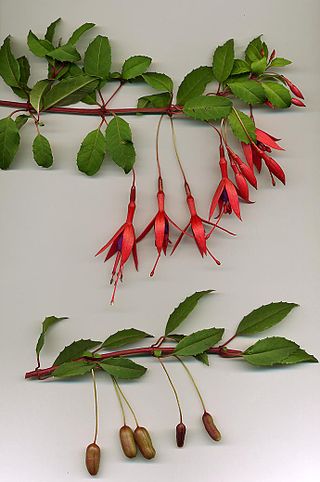
Fuchsia magellanica – commonly known as the hummingbird fuchsia, hardy fuchsia or chilco – is a species of flowering plant in the evening primrose family Onagraceae, native to the lower Southern Cone of southern South America.

Justicia floribunda is a species of flowering plant in the acanthus family Acanthaceae, native to southern Brazil, Paraguay, and Misiones Province of northeastern Argentina.

Coleus scutellarioides, commonly known as coleus, is a species of flowering plant in the family Lamiaceae, native to southeast Asia through to Australia. Typically growing to 60–75 cm (24–30 in) tall and wide, it is a bushy, woody-based evergreen perennial, widely grown for the highly decorative variegated leaves found in cultivated varieties. Another common name is painted nettle, reflecting its relationship to deadnettles, which are in the same family. The synonyms Coleus blumei, Plectranthus scutellarioides and Solenostemon scutellarioides are also widely used for this species.
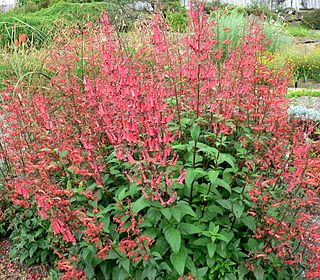
Phygelius, common names Cape fuchsia or Cape figwort, is a genus of flowering plants in the family Scrophulariaceae, native to wet slopes and banks in southern Africa. They are evergreen shrubs often treated as perennials in colder climates. They bear many pendent tubular flowers over a long period in summer, in shades of white, yellow and red. The vague similarity of the blooms to fuchsias has led to the common name Cape fuchsia, though they are not closely related.
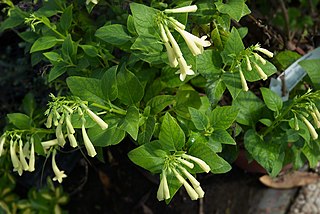
Phygelius aequalis is a species of flowering plant in the family Scrophulariaceae, native to South Africa. It is a semi-evergreen shrub growing to 1 m (3 ft) tall and wide, with 25 cm (10 in) long panicles of pink flowers with crimson lobes and yellow throats. This species may be distinguished from the closely related Phygelius capensis by the fact that the flowers grow in a single plane along one side of the stem. The narrowly tubular flowers are up to 6 cm (2 in) in length.

Phlox paniculata is a species of flowering plant in the phlox family (Polemoniaceae). It is native to parts of the eastern and central United States. It is extensively cultivated in temperate regions as an ornamental plant and has become established in the wild in scattered locales in other regions. Common names include fall phlox, garden phlox, perennial phlox, summer phlox, and panicled phlox.

Diascia is a genus of around 70 species of herbaceous annual and perennial flowering plants of the family Scrophulariaceae, native to southern Africa, including South Africa, Lesotho and neighbouring areas.
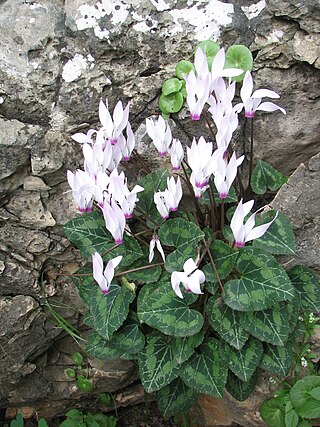
Cyclamen persicum, the Persian cyclamen, is a species of flowering herbaceous perennial plant growing from a tuber, native to rocky hillsides, shrubland, and woodland up to 1,200 m (3,900 ft) above sea level, from south-central Turkey to the Levant. It also grows in Algeria and Tunisia and on the Greek islands of Rhodes, Karpathos, and Crete, where it may have been introduced by monks. Cultivars of this species are the commonly seen florist's cyclamen.

Veltheimia capensis is one of two species of flowering plants belonging to the genus Veltheimia, of the family Asparagaceae. It is a tender bulbous perennial reaching a height of 46 cm (18 in), with flowers varying in color from white with red spots to pink with green or red markings.

Verbascum phoeniceum, known as purple mullein, is a species of mullein that is part of the family Scrophulariaceae native to Central Europe, Central Asia and Western China. It is also naturalized in certain regions of the US and Canada. It successfully grows in USDA’s zones 4 to 8. It is a short-lived perennial species, and blooms earlier than other mullein species on average, producing vibrant purple-pink flowers; it can grow up to 1m or more.

Crassula ovata, commonly known as jade plant, lucky plant, money plant or money tree, is a succulent plant with small pink or white flowers that is native to the KwaZulu-Natal and Eastern Cape provinces of South Africa, and Mozambique; it is common as a houseplant worldwide. Much of its popularity stems from the low levels of care needed; the jade plant requires little water and can survive in most indoor conditions. It is sometimes referred to as the money tree; however, Pachira aquatica also has this nickname.

Drimia capensis ("Maerman") is a species of geophytic flowering plant in the family Asparagaceae, subfamily Scilloideae, indigenous to the south-western parts of South Africa.
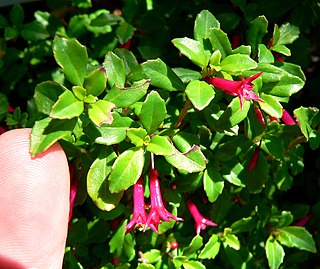
Fuchsia microphylla, also known as small leaf fuchsia and small-leaved fuchsia, is a flowering shrub in the family Onagraceae. The specific epithet (microphylla) was named for the plant's small (micro) leaves (phylla).




















